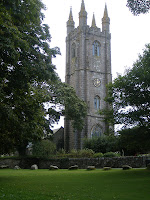
Wonderful Widecombe-in-the-Moor, a gem of a village with a stunning church described as "The Cathedral of the Moors" . . . Sabine Baring-Gould (along with C Henry Warren, another old literary friend of mine, now long dead . . .) wrote eloquently of Widecombe (pronounced "Widdicwm" - my use of the 'w' being the equivalent of a short 'o'):
"I shall never forget a drive through Widdecombe one October day, when the sun was shining bright, and the air was soft. The sycamores had shed their leaves; but the expedition was one through coral land. The rowan, or mountain-ash, which was everywhere, was burdened with clusters of scarlet berries, and the hedges were wreathed with rose-hips and dense with ruddy haws."
 The National Trust has commandeered one end of this lovely old church building, the part which was once the Sexton's cottage. Called Church House, it was built in 1537, primarily for the brewing of church ales . . . It later became almshouses, a school and a workhouse. It is now the village hall.
The National Trust has commandeered one end of this lovely old church building, the part which was once the Sexton's cottage. Called Church House, it was built in 1537, primarily for the brewing of church ales . . . It later became almshouses, a school and a workhouse. It is now the village hall. Inside the church is the socket for an earlier cross and two small early Medieval crosses.
Inside the church is the socket for an earlier cross and two small early Medieval crosses.
 This is taken from his book, "A Book of Dartmoor", first published in 1900. He continued:
This is taken from his book, "A Book of Dartmoor", first published in 1900. He continued:"The church of Widdecombe has a very fine tower, built, it is said, by the tinners. The roof has many of the original bosses, carved and painted with heads, flowers and leaves. One has the figure on it of St Catherine with her wheel. One boss has on it three rabbits, each with a single ear, which unite in the centre, forming a triangle. One exactly similar is in Tavistock church (and see Chagford entry too, for details of same). Part of the lower rood screen remains with figures of (painted) saints on it."
 The boss of the three tinners' rabbits.
The boss of the three tinners' rabbits.
This boss features a goat, which was a symbol of backsliding and laviciousness . . .
 This is the Green Man, which you will remember from one of my posts earlier this year. He is a country-wide phenomenon.
This is the Green Man, which you will remember from one of my posts earlier this year. He is a country-wide phenomenon. I hope you can read the writing on this when it is enlarged, as it tells you about each and every roof boss.
I hope you can read the writing on this when it is enlarged, as it tells you about each and every roof boss. These roof bosses feature the Pelican (left) and the Cockerel (right).
These roof bosses feature the Pelican (left) and the Cockerel (right).The story of the great thunderstorm in which Widdecombe church was struck, on Sunday, October 21st, 1638, when the congregation were present at divine service, has often been told, notably by Mr Blackmore in his novel "Christowel".
Prince, in his Worthies of Devon, thus narrates the circumstances: -
"In the afternoon, in service time, there happened a very great darkness, which still increased to that degree, that they could not see to read; soon after, a terrible and fearful thunder was heard, like the noise of so many great guns, accompanied with dreadful lighning, to the great amazement of the people; the darkness still increasing that they could not see each other, when there presently came such an extraordinary flame of lightning, as filled the church with fire, smoak, and a loathsome smell, like brimstone; a ball of fire came in likewise at the window, and passed through the church, which so affrighted the congregation, that most of them fell down in their seats; some upon their knees; others on their faces, and some one upon another, crying out of burning and scalding, and all giving themselves up for dead. There were in all four persons killed, and sixty-two hurt, divers of them having their linen burnt, tho' their outward garments were not so much as singed . . . The church itself was much torn and defaced with the thunder and lightening, a beam whereof, breaking in the midst, fell down between the minister and the clerk, and hurt neither. The steeple was much wrent; and it was observed that the church was most torn, there the least hurt was done among the people. There was none hurted with the timber or stone; but one man, who, it was judged, was killed by the fall of a stone."
We enjoyed wandering around the village, exploring the church, and the little pottery shop which was once the blacksmith's premises, with its uneven stone floor, and the incredible chair which used to belong to Uncle Tom Cobley himself, but that (and Uncle Tom's story) is worthy of its own seperate page.
2 comments:
I hadn't heard the story of the church and the storm before but been to the village before. It's really pretty isn't it.Glad you had a nice day there.
What a nice blog for a Sunday Jennie....wish I could see it in person but you are a great tour guide.
Post a Comment